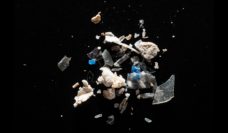Nail salon technicians, many nail salon owners as well, are some of the most inspiring hard-working entrepreneurial people I have met through my 15-years of research experience in occupational health. Many of them want the industry to be better and have expressed difficulty choosing safer nail products. I understood this best when studying the composition of plasticizers, which are chemicals that are added to make nail polish more flexible and durable.
My colleagues and I recently documented the evolution of labels and ingredients in nail polish related to plasticizer components. We examined plasticizer content disclosed by the manufacturers versus what we measured in the laboratory for 40 different nail polishes from 12 brands, including regular polish and one long-lasting gel polish. We found that manufacturers may be using potentially toxic plasticizer substitutes, even in products that don’t list them or claim these plasticizers are excluded.
Our study documents how the nail polish industry has been responding to market demands and has started labeling nail polishes using an “n-free” labelling system. The “n” is the number of substances not present. For example, 3-free, the most common label on nail polishes, implies the absence of three known toxic substances, often referred to as the “toxic trio”: toluene, di-n-butyl phthalate (DnBP), and formaldehyde. The higher the n, the more ingredients were removed from the nail polish. Although it is encouraging to see the industry moving towards eliminating some concerning chemicals, many challenges remain when nail technicians or consumers want to choose safer nail polishes.
For a consumer of nail polish, in the salon or at home, reading ingredients in nail products is essential to choosing safer products — especially in lieu of being able to test products for safety ourselves. However, ingredients are not always listed on the bottle or packaging, or the distribution sites. In some instances, to learn about ingredients we had to rely on product safety data sheets, which were not always available on the manufacturer website or distribution sites, or resort to publicly available technical sheets about the products.
Nail salon technicians, many nail salon owners as well, are some of the most inspiring hard-working entrepreneurial people I have met through my 15-years of research experience in occupational health.
Users wanting to avoid phthalate ingredients, a common plasticizer in nail polish, will not find it easy. Fragrances in nail polish may not disclose phthalate ingredients. N-free labels can help you know what ingredients were removed, but not what was added as a replacement. Specifically, our study identifies the use of bis(2-ethylhexyl) phthalate (DEHP) as a potential substitute to the historically common nail polish plasticizer phthalate DnBP, even among nail polishes with newer n-free labels.
We recommend labeling validation, removal of harmful ingredients by chemical class, and safety testing of substitutes, although practical implementation of our recommendations may need much more research to identify feasible and effective solutions. There is also much to be studied beyond n-free claims. Some nail polishes add labels such as “non-toxic,” “organic,” “child safe,” “non-allergenic,” that we did not study.
And why should we care about these plasticizers in nail polish? First, workers in nail salons carry a high exposure burden. Second, plasticizer chemicals are everywhere in our environments and nail polish just adds another source of exposure during our lifetime. It is challenging to know the potential negative health impact from exposure chemicals during the occasional manicure. Plasticizers concern public health researchers because many have been associated with negative health concerns including reproductive and endocrine issues.
By advancing health research related to nail products, we hope to push policy that helps nail polish users and, most importantly, nail technicians to be healthier. This is just fair! Nail technicians work hard and may be putting their own health at risk to help us relax and feel beautiful.
Photo by DESIGNECOLOGIST on Unsplash














